

Insomnia can’t be cured without treating the underlying imbalance that causes it. In this chapter you’ll learn how to restore balance to your mind/body system through meditation, diet, exercise, and herbal food supplements.
All this will not only improve your sleep but foster success in every area of your life. Because insomnia, after all, is more than just a sleep disturbance. It is an expression of an overall imbalance in the physiology. According to Ayurveda, sleep is one of the pillars of health—so when sleep is disturbed, it represents a basic disruption of physiological stability. Even though sleep, in a purely technical sense, can be attained through the use of tranquilizers or other medications, we’ve seen that loss of consciousness by artificial means will not achieve balance in the body. In contrast, Ayurveda considers balance in an extremely comprehensive way, taking into account mind/body behavior as well as the environmental context.
In this regard, I would like to introduce a relaxation technique for creating tranquillity in your thoughts. You can use this technique when you’re ready to go to bed or during the day when you feel the need to relax. It’s a very simple but very powerful form of meditation.
I like to say that meditation is not at all a way of making your mind be quiet; rather, it’s a way of entering into the quiet that’s already there, buried under the fifty thousand thoughts an average person thinks every day. And, of course, most of those thoughts are really more than reflexes; they’re automatic mental responses we’ve developed from conditioning that has filled us with anxiety and fear. They’re nothing more than habits, and 99 percent of the thoughts you have today are the same ones you had the day before.
Yet all this mental static only masks the profound internal silence that is the real source of happiness, inspiration, and peace. Once you gain access to this silent realm of your mind, you achieve freedom from all those random images that trigger worry, anger, and pain.
Although you can use this technique anywhere, our present purpose here is to overcome insomnia and bring about good sleep. Therefore, when you use the technique, it’s best to wait until you’re in bed and ready to bring the day to a close. Let me emphasize that you should never undertake any sort of meditation while driving a car or operating any sort of machinery.
To begin, sit or lie down quietly with your hands lightly at your sides or folded in your lap. Then close your eyes, begin to breathe easily and naturally, and let your attention follow your breathing.
Feel your breath entering your nostrils and flowing down into your lungs. You don’t need to inhale deeply or hold your breath, just breathe normally and easily. When you exhale, let your attention follow the air up out of your lungs and softly out through your nostrils.
Nothing needs to be forced. Just feel your breath moving gently and easily, with your attention following it as naturally and effortlessly as a shadow.
Now, as your breathing relaxes, let it become a little lighter. Again, there’s no need to force this, but when you feel that your breath is growing a bit shallower and lighter, simply let it happen. If you start to feel a bit short of breath, don’t worry; however, this might mean that you’re forcing your breathing to become lighter than it wants to be. So return naturally to whatever rate of breathing your body feels comfortable with.
Continue this exercise for two to five minutes, keeping your eyes closed and focusing your mind on easy, natural breathing.
When you’ve practiced this technique a few times, you’ll begin to notice how, just by paying attention to your breathing, your body sinks deeper and deeper into relaxation, and your mind naturally becomes quieter, too. Before long you’ll get a few glimpses of a profound and complete silence. You won’t have to look for this silence; you’ll just begin to lose track of your thoughts, and then the silence will simply appear.
As you gain experience with meditation, you’ll of course begin to sleep better at night. But you’ll also experience a kind of energy and vitality during the day that has its source at a deep level of the nervous system. This is a very profound change and an enormous benefit, and it could certainly never be brought about by medication.
Perhaps the main distinction between the modern nutritional understanding of diet and that of Ayurveda is that modern nutrition understands food only in terms of its material qualities.
To get an idea of what this means, consider the broad range of nutritional terminology that is used today: protein, carbohydrates, fats, minerals, cholesterol, vitamins, calories, and so forth. Each of these terms describes a particular material or chemical quality of food. Ayurveda, on the other hand, interprets the influence of food in terms of its intelligence value. Ayurveda recognizes the material value of the food, but it also explains that a more basic level of influence is derived from every form of nutrition. This influence is on the level of the mind/body connection. In other words, it is intelligence.
To understand what it really means to influence the physiology from this level, think of a tree with all its different elements: branches, bark, leaves, and fruits. It should be clear that the most effective way to influence the tree would not be to approach each element—each leaf or branch or fruit—individually. Instead, by bringing water to the tree, nature’s intelligence is imparted to each and every one of its many aspects.
Similarly, your diet can influence your mind/body system in a very profound way. You’ve already learned the Ayurvedic terminology that can help you understand how to produce this influence. You can understand, therefore, that every food will influence the physiology through the doshas, which in turn govern the flow of nature’s intelligence in the physiology.
Vata, of course, is the most important dosha in treating insomnia. This is because Vata governs all movement, and excess Vata is responsible for the excessive mental activity or hyperarousal that so commonly results in sleeplessness. The comprehensive nutritional knowledge of Ayurveda ascribes to every substance and every food a particular influence on Vata, Pitta, and Kapha. For instance, certain foods are known to reduce Vata in the body. Eating these foods helps to transform the physiology so as to produce a more balanced state of functioning and a more settled awareness, and this in turn will alleviate insomnia. While it’s not necessary to stick to this Vata-pacifying diet very strictly, you should try to eat according to these principles:
It is very important to eat your meals regularly. As discussed in the lesson on biological rhythms, taking meals at a set time helps reset your body’s biological clock. Remember that lunch is the time for the most important meal, and it should also be the heaviest meal of the day.
In general, favor warm, cooked, substantial meals. Balanced, solid meals, eaten on a regular schedule, will help soothe and settle the Vata dosha and make the body more comfortable at bedtime.
In describing nutrition, Ayurveda refers to six tastes: sweet, sour, salty, pungent, bitter, and astringent. The first three are those that most effectively pacify the Vata dosha. While a balanced diet will include all six tastes, these three should be emphasized. It’s important to note that “sweet” does not mean just “sugary” but includes many wholesome foods such as milk, bread, grains, and pasta. Although the sweet taste is beneficial for Vata, concentrated sugar eaten by itself often gives a quick energy boost that can make Vata types feel very restless. If you eat a sugary sweet, take it along with something more nourishing, such as milk, which will balance the effect.
| Sweet | Sugar, milk, butter, rice, breads, pasta |
Sour |
Yogurt, lemons, cheese, vinegar, sour-tasting fruits |
| Salty | Salt |
Pungent |
Spicy foods, ginger, hot peppers, cumin, radishes |
| Bitter | Bitter greens (endive, chicory, romaine lettuce); other green, |
|
leafy vegetables; tonic water; turmeric; fenugreek |
| Astringent | Beans, lentils, pomegranates, cabbage, apples, potatoes, pears |
| Decrease Vata | Sweet, sour, salty |
Increase Vata |
Pungent, bitter, astringent |
| Decrease Pitta | Sweet, bitter, astringent |
Increase Pitta |
Pungent, sour, salty |
| Decrease Kapha | Pungent, bitter, astringent |
Increase Kapha |
Sweet, sour, salty |
| Favor foods that are warm, heavy, and oily |
| Minimize foods that are cold, dry, and rough |
| Favor foods that are sweet, sour, and salty |
| Minimize foods that are spicy, bitter, and astringent |
Dairy. All dairy products pacify Vata. Always boil milk before you drink it, and drink it warm. Don’t drink milk with a full meal.
Sweeteners. All sweeteners are good (in moderation) for pacifying Vata. However, concentrated sugar, when eaten by itself, can give a quick energy boost and make you feel extremely restless. If you eat a sugary sweet, try combining it with something more nourishing, like milk, to balance the effect. Raw, unrefined sugar, available in health food stores, is preferable to refined sugar.
Oils. All oils are good, as they reduce Vata.
Grains. Rice and wheat are very good. Reduce your intake of barley, corn, millet, buckwheat, rye, and oats.
Fruits. Favor sweet, sour, or heavy fruits, such as oranges, bananas, avocados, grapes, cherries, peaches, melons, berries, plums, pineapples, mangoes, and papayas. Reduce astringent or light fruits, such as apples, pears, pomegranates, and cranberries.
Vegetables. Beets, cucumbers, carrots, asparagus, and sweet potatoes are good. They should be eaten cooked, not raw. The following vegetables are acceptable in moderate quantities if they’re cooked, especially with ghee or oil and Vata-reducing spices: peas; green, leafy vegetables; broccoli; cauliflower; celery; zucchini; and potatoes. It’s better to avoid sprouts and cabbage.
Spices. Cardamom, cumin, ginger, cinnamon, salt, cloves, mustard seed, and small quantities of black pepper are acceptable.
Nuts. All nuts are good.
Beans. Reduce all beans, except for tofu.
Meat and fish (for nonvegetarians). Chicken, turkey, and seafoods are acceptable. Beef should be avoided.
Write down your favorite foods and spices from the Vata-Pacifying Diet. Then plan a few meals that include these foods. Record how you felt after eating these meals.
| 1. | 6. | 11. |
| 2. | 7. | 12. |
| 3. | 8. | 13. |
| 4. | 9. | 14. |
| 5. | 10. | 15. |
Another useful tip for pacifying Vata is to avoid cold foods and drinks, especially those that are iced. This is because the Vata dosha is cold by nature, and anything cold will increase this effect. When you go out to dinner, ask for warm water to sip in place of ice water. Take the hot soup instead of the salad, and feel free to eat bread and butter as well as dessert, preferably a warm dessert like apple pie rather than ice cream, whose coldness will increase Vata in the system.
Remember that caffeine, cigarettes, and alcohol have been shown to interfere seriously with normal sleep. Alcohol eventually produces a state of drowsiness, of course, and can bring about loss of consciousness, but this is not natural sleep. The brain waves of people who drink alcohol show entirely different patterns from those of normal sleepers. For one thing, the dream stage of sleep is entirely bypassed. As a deficit of natural sleep builds up with continued alcohol use, there can be a very negative effect on general health.
This is especially true for a person in whom Vata has been disturbed. Even a single cup of tea or coffee, taken in the morning, can interfere with sleep that night. Don’t forget that most soft drinks also contain caffeine, and that carbonated beverages in general will increase Vata and so should be minimized. Also, many prescriptions and over-the-counter medications contain stimulants. As we’ll discuss in chapter 8, it is very common for people to experience sleep problems related to their medications. Consult your physician to determine whether this might apply to you.
Heavy food at dinner is not recommended. Although it may seem unusual, a hot breakfast cereal for dinner will taste extremely good to anyone suffering from a Vata imbalance. Other soothing, relatively light dinners are hearty minestrone soup, rice served with buttered lentils, or pasta in any form. Warm milk before bed is a good idea, but a late-night snack is not.
Before leaving the subject of diet, I’d like to introduce a special technique for eliminating impurities or toxins from the system. In Ayurveda these impurities are called amas. Amas block normal functioning of the physiology and disturb the doshas. They are the residues of foods that have not been properly digested and that remain in the system in the form of toxins. Often they originate in greasy, stale, or heavy foods such as cheese or products made with white flour or refined sugar.
Sipping hot water during the day is an easy and effective way to dissolve ama and so eliminate it from the system. The concept is a simple one: Ama is described in Ayurvedic texts as a sticky white substance that clogs the channels of the physiology. When you wash dishes that are greasy or sticky, you use hot water to clean them; you can use hot water in the same way to remove ama gradually from your system.
While this method may sound remarkably simple, once you try drinking hot water you’ll be impressed by the results. In addition to benefiting your sleep, your body will feel lighter and more energetic, and you’ll experience a balanced mental awareness. But there is a specific routine that you must follow to produce this effect. First, the water should be very hot—so hot that you have to blow on it before you sip it. Second, the amount of hot water you take is less important than how frequently you take it. For best effect, the water should be sipped about every thirty minutes. If this seems too frequent for you, then take one or two sips of hot water every hour at the minimum. You can have much more if you like, according to your thirst.
You may also have other liquids during the day, but always take your hot water. The easiest way for most people to do this is to buy a good thermos and fill it in the morning with boiling water, which will remain hot for about ten hours. After a few days you will feel so soothed and balanced from this routine that you’ll begin to look forward to it. You may find that for the first few weeks you urinate more frequently—and it may seem like even more than the amount by which you have increased your fluid intake. This is because the body is beginning to flush itself out to remove toxins and impurities from the system. It’s a sign that something powerful is happening. After a few weeks the urine will return to normal, but the ama will continue to be eliminated from the system.
Exercise is an important part of creating balance for any physiology. Cherak, one of the first Ayurvedic physicians, said the following: “From physical exercise, one gets lightness, capacity to work, firmness, tolerance of difficulties, diminution of physical impurities, and strengthening of digestion and metabolism.”
While exercise is important for everyone, excessive exercise can be damaging. The three most common mistakes people make in relation to exercise are, first, taking too little exercise or none at all; second, performing exercises that don’t suit their body type; and third, exercising beyond the point where risks begin to outweigh benefits. Therefore, the amount and type of exercise should be carefully suited to the individual. Above all, the purpose should be to produce energy and strength and vitality, not to use it up. You should feel lively, strong, and energetic during a workout and afterward. If you feel exhausted and strained at any point, then something is wrong with that particular program.
Sleep research shows inconsistent effects of exercise on sleep. Perhaps this is because the studies do not take into account the different body types of the individuals participating in the studies and the types of exercise they need. Of the three doshas, Kapha requires the most exercise. Vata requires the least, with Pitta in the middle.
Because insomnia is predominantly a Vata disorder, Ayurveda recommends only light to moderate exercise for those suffering from this problem—about thirty minutes per day of continuous motion. Brisk walking, cycling, swimming, and certain indoor exercises, such as stationary bicycling or a crosscountry ski machine, are recommended. Always keep in mind the fact that excessive exercise can disturb Vata, and that too much exercise can be as harmful as too little.
If you’re in the habit of vigorous exercise such as jogging five to ten miles at any time, try cutting back by half for one month and see what the effect is on your sleep. The Ayurvedic principle is to exercise to about 50 percent of your capacity. If you can bicycle twenty miles, do ten. If you usually run ten miles, run five. Your ultimate capacity is that point when you are completely tired and must stop, when you literally can’t go any farther. Since what we want from exercise is not to spend all of our energy but rather to produce more of it, reaching the point of exhaustion should never be the goal. By stopping at about 50 percent, you should still feel energetic and comfortable, never strained or tired. In any case, the principle of utilizing half of your capacity does not violate the principles of physical conditioning. On the contrary. With regular exercise, your total capacity will increase, so that 50 percent of that capacity will also be increasing.
Integrating thirty minutes of walking once a day into your daily routine will have a profound effect in balancing the physiology and producing a more settled state of mind. The best time for exercise is during the Kapha period of morning, 6:00 to 10:00 A.M. On the other hand, exercising in the evening can aggravate insomnia by overstimulating the system too close to bedtime. In addition to walking, neuromuscular and neuro-respiratory integration exercises balance all three doshas simultaneously. These exercises, coming from the yoga tradition, not only benefit muscular and metabolic performance but enhance coordination between mind and body. Many people have found that neurorespiratory exercise, breathing exercise, produces a more settled state of awareness and is very useful for the treatment of insomnia.
Exercise every day, using these Ayurvedic guidelines:
Take a daily 30-minute walk. The best time is during the Kapha period in the morning, 6:00–10:00 A.M. Do not exercise (aside from easy walking) after 6:00 P.M.
You can substitute other light to moderate exercises of a continuous motion, such as cycling and swimming. Using a stationary bicycle or cross-country ski machine is also recommended.
Use only 50 percent of your capacity. For example, if you can cycle six miles, cycle three. If you are capable of swimming eight laps, stop after four. With regular exercise, your capacity will grow.
Do not strain. You should feel strong and energetic during and after exercise.
If you are in the habit of exercising vigorously, try cutting back by half for one month and see what effect this change has on your sleep.
Do the following Neuromuscular and Neurorespiratory Integration Exercises for a few minutes daily. If possible, do them twice a day before you meditate. The best times are in the morning after bathing and in the evening before supper.
These simple exercises, or yoga postures, help restore mind/body coordination and balance all levels of your body’s functioning.
Be careful not to strain by stretching too far. The drawings show the ideal performance of each exercise, but should stretch only as far as your body is comfortable. Over time you will develop more flexibility. You should definitely avoid stretching to the point of pain or discomfort.
If even minimal performance of a particular posture causes pain or discomfort, omit that posture. If you have a chronic or acute muscular or skeletal condition (back problem), consult your physician before doing these exercises.
If you feel that you cannot bend a particular part of your body, don’t force your body by swinging. Just bend to the extent you can, without trying to force.
Hold each posture for only a few seconds and then release it easily. Just breathe naturally during the exercises—do not hold your breath.
Wear comfortable, loose clothing. Use a folded wool blanket, rug, or exercise mat rather than the bare floor.
Do not perform the postures on a full stomach. This means you should wait at least two or three hours after a meal before doing these exercises.
When you are performing these postures, easily allow your attention to focus on the area of your body that is being stretched. By doing the postures in quiet and without disturbance, your attention will automatically be drawn to that area of your body. Just by allowing your awareness to be on the area of maximum stretch, you will gain the maximum benefit from the exercise.
These exercises take only about five minutes if you perform each posture once. If you have time, you can repeat each exercise three times.
Be sure to follow the sequence of poses given below, as each pose is designed to prepare your body for the next one.
This two-minute body massage gently increases circulation, moving your blood in the direction of your heart.
Sit comfortably. Use the palms and fingers of both hands to press the top of your head, gradually moving them toward your face, neck, and chest while pressing and releasing. Then start again at the top of your head and gradually press and release down over the back of your neck and around to your chest.
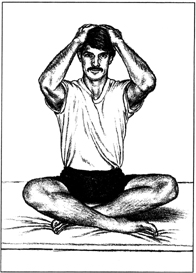
Grasp the fingertips of your right hand with the palm and fingers of your left hand, gradually pressing and releasing your arm up to your shoulder and chest. First do the upper side of your arm, then repeat on the underside. Then massage your left arm in the same way.
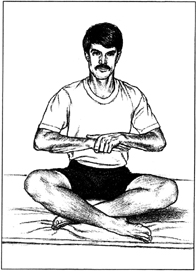
With the tips of your fingers meeting horizontally at the navel, begin to press and release your abdomen, gradually moving the pressure up toward your heart, reaching almost to your chest.
Use both hands to press and release the middle of your back and ribs up toward your heart as far as you can reach.
Start with your right foot, massaging your toes and sole and gradually pressing and releasing up your calf, thigh, and waist. Repeat with your left foot.

Lie on your back, draw your knees up to your chest, and clasp your hands over your knees. Raise your head slightly. Roll to the right until your right wrist touches the floor, then roll to the left. Repeat five times in each direction, then slowly stretch your legs out until you are lying on your back. Rest for a few seconds.

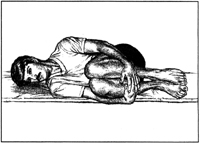
This exercise prepares your body for the other postures, strengthening your pelvic area and back.
Kneel down, sitting on the flats of your feet, with heels apart and your big toes crossed. Place your hands in your lap, palms up. Hold your head, neck, and spine in a straight line.
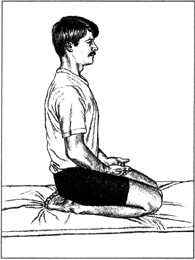
Next, lift your buttocks off your heels until you are in a kneeling position. Then slowly lower your body and sit down on your heels again. Repeat, moving slowly and smoothly.
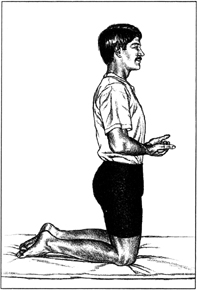
This posture strengthens and relaxes your spine and abdominal organs, aiding in digestion.
Sit and stretch your right leg in front of you. Bend your left leg so the sole of your foot is touching the inside of your thigh.

Bend forward and touch your right foot with your hands, arms outstretched. You can bend your right knee if you need to. Hold the pose for a few seconds, then slowly release it and come up to a sitting position.
Repeat the exercise, using your other leg.
4 SHOULDER STAND
This posture enlivens the endocrine system and the thyroid gland, relieves mental fatigue, makes your spine more flexible, and has a soothing effect on your body.
Lie on your back. Slowly raise your legs to a half-vertical position, over the waist. Support your back with your hands above your hips, keeping your elbows in toward your body.

Tilt your feet more toward your head. Hold the pose for half a minute.
Slowly return to the original position by bending your knees to balance your trunk until your buttocks touch the floor, then straighten your legs and lower them slowly. Relax gradually. Breathe normally and naturally throughout all the exercises.
Be careful not to strain your neck or throat—this is a shoulder stand, not a neck stand.
5 PLOW POSE
This pose strengthens and relaxes your back, neck, and shoulders. It normalizes the functioning of the liver, spleen, and thyroid and removes fatigue.
From the shoulder stand, continue into this position as you bend from your pelvis and bring both legs down over your head.
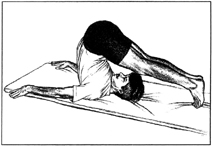
Allow your legs to go back only as far as feels comfortable. Be careful not to put too much strain on your neck. Extend your arms straight out behind you. Your torso should rest on the tops of your shoulders, your hips maintaining a vertical line with your shoulder joints. Cross your arms over your head, holding for a few seconds.
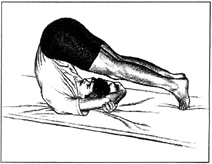
Slowly return to a prone position by bending your knees to balance your torso until your buttocks touch the floor. Then straighten your legs and lower them slowly. Relax.
6 COBRA POSE
This exercise strengthens and relaxes your back muscles and helps with irregularities in the ovaries and uterus.
Lie on your chest with your palms directly under your shoulders, fingers pointing forward. Place your forehead on the floor.
Slowly raise your head and chest, keeping your elbows close in to your body, and maintain the pose for a few seconds.
Bend your elbows, slowly lowering yourself until you are lying comfortably, resting your right or left cheek on the floor. Relax completely.
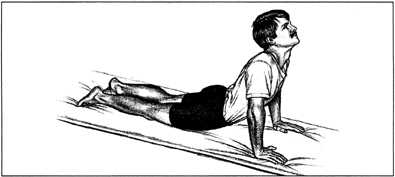
7 LOCUST POSE
This posture strengthens your lower back, aids in digestion, and balances the bladder, prostate, uterus, and ovaries.
Continue to lie on your chest, with your arms along the sides of your body, palms up. Let your chin rest gently on the floor.
Raise your legs in a straight position, extending them upward and back. Hold the pose for a few seconds while breathing easily. Then release your legs slowly.
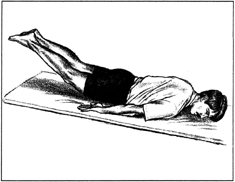
If you find it difficult to raise both legs together in the beginning, do not strain. Try raising one leg at a time.
8 SEATED TWIST POSE
This pose increases circulation in the liver, spleen, adrenal glands, and kidneys. It also releases tightness in the shoulders, upper back, and neck.
Sit with your legs stretched out in front of you.
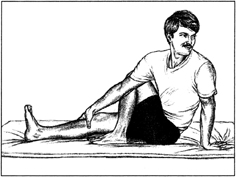
Raise your left leg so that your foot is on the floor near your right knee.
Put your left hand on the floor behind you.
Gently turn your torso to the left, press your right forearm against the outside of your left knee, and grasp your right leg below the knee.
Turn your head and torso to your left.
Maintain the pose for a few seconds and come back slowly to the original seated position. Repeat the pose with your other leg.
This exercise strengthens internal functioning of the liver, stomach, spleen, and kidneys. It tones the spine and soothes and relaxes the mind.
Stand up straight with your feet parallel, about as wide apart as your hips. Stand with your weight distributed evenly on both feet.

Bend forward until your hands touch your toes (or as far as is comfortable). Stretch your arms and allow your forehead to either touch your knees or be near them. Notice that your abdomen is naturally drawn in during this pose.

This soothing pose eliminates fatigue and rejuvenates the body and mind.
Lie on your back, allowing your arms to rest easily by your sides with your palms up.
Allow your body to relax. Close your eyes and let your awareness be easily drawn to any part of your body or to your body as a whole.
Rest for at least one minute, breathing easily and naturally.
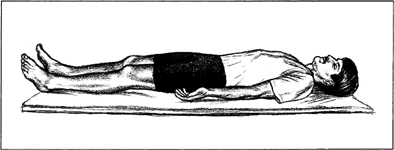
This simple exercise, called Pranayama, creates balance throughout your body. It helps settle your awareness, which is especially useful in treating insomnia. It’s ideal to do Pranayama after the Neuromuscular Integration Exercises.
Sit easily and comfortably with your spine as straight as possible.
Close your eyes and rest your left hand on your knees or thighs. For this exercise you will be using your thumb and the middle and ring fingers of your right hand.
Using your right thumb, close off your right nostril. Start by exhaling through your left nostril. Then inhale easily through your left nostril.
Now use your ring and middle fingers to close your left nostril. Exhale slowly through your right nostril, then easily inhale.
Continue alternating nostrils for about five minutes. Your breathing should be natural, not exaggerated. It may be a little slower and deeper than usual.
When you are finished, sit quietly with your eyes closed for a few minutes while breathing easily and normally.
Continue using your Daily Sleep Log and Bedtime Checklist.
Thousands of naturally occurring herbs are utilized in Ayurveda and are considered food supplements. Just as food influences physiology at the basic level of nature’s intelligence, herbs are also beneficial on this level, but they can be utilized more precisely to influence a particular aspect of Vata, Pitta, or Kapha doshas. With regard to insomnia, herbal supplements are used as part of an overall strategy that includes creating balance in the physiology at all levels—body, mind, and spirit. Ayurveda considers the following herbs in various combinations particularly useful for treating insomnia. These combinations are available through the Ayurvedic resources whose addresses are provided at the back of this book.
The herbs, along with some of their properties, are:
Jatamamsi, a close relative of tagara, which creates cooling energy and aids digestion
Ashwagandha, rejuvenating herb, which calms the nerves and promotes satisfying rest
Shakhanalpushpi, another herb which strengthens the nervous system and calms the mind
Brahmi, which is useful for pacifying Pitta as well as Vata
Jatiphala, one of the best herbs for treating the nervous disorders that can disrupt sleep
Tagara, whose Latin name is valerian, especially useful for cleansing accumulated Vata from the nervous system. The usefulness of valerian as a sleep aid has been confirmed by Western medicine in a study conducted in Switzerland. Among 128 subjects, the herb did improve sleep and there were no measurable side effects.
Although the herbs listed above are naturally occurring substances that have been used for thousands of years in many societies, any preparation can cause an unwanted reaction in some individuals. If you’re interested in using herbs to help you sleep, be sure to do so with the guidance of experienced Ayurvedic teachers, some of whom can be contacted through the addresses provided at the end of this book.
Some of the points covered in this chapter may seem related less to insomnia than to altering your bedtime, but remember that Ayurveda’s approach is both comprehensive and unique. It is an extremely thorough process that allows you to simultaneously balance mind, body, behavior, and environment. You’ll be surprised at the effects that these additional routines will have in enhancing your well-being; they will help not only in overcoming insomnia but in all areas of your life.